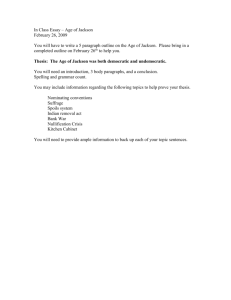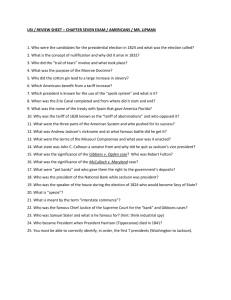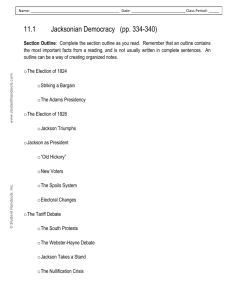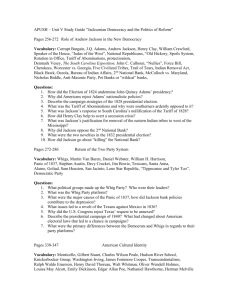Presentation
advertisement
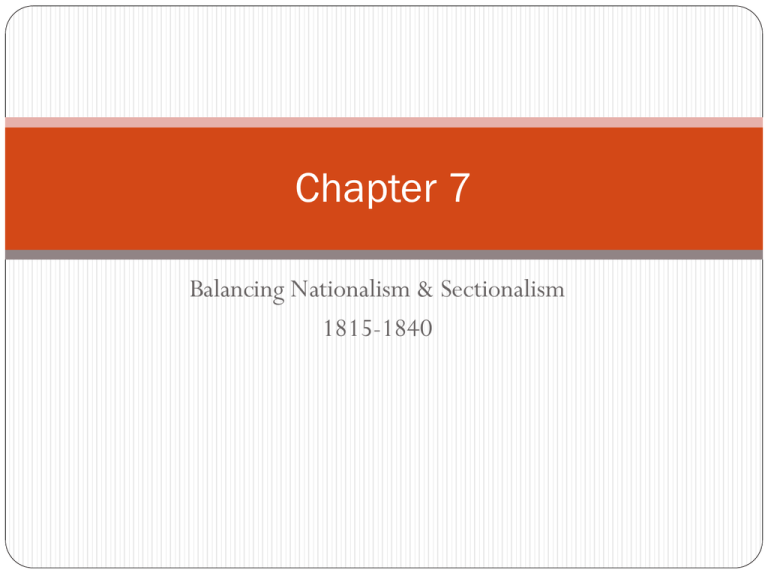
Chapter 7 Balancing Nationalism & Sectionalism 1815-1840 Section 1 Regional Economies Create Differences Two Economic Systems Develop By the 1800’s, the production of goods had moved from small workshops to large factories that used machines. This change was partly due to Eli Whitney. In 1798, he found a way to make goods using interchangeable parts. These parts were standardized and could be used in place of one another. In factories, power-driven machinery and many laborers made mass production possible. Mass production is the production of goods in large amounts. Continued The changes in manufacturing brought about an Industrial Revolution. This was the name given to the massive changes to both the economy and society that resulted from the growth of the factory system. Industrialization in America took place mainly in the New England states because farming was difficult in New England. As a result, people were more willing to manufacture goods. Continued Farmers in the North began to raise livestock & crops for sale so they could buy goods made in Northern factories. A market economy developed. A market economy is an economy in which manufacturing and agriculture support the growth of each other. Due to manufacturing, the North did not depend on slave labor. However, the South’s economy had long been based on agriculture. Continued IN 1793, Eli Whitney helped to further promote agriculture by inventing the cotton gin. The machine helped to clean the cotton and increased cotton production, which led to the establishment of large cotton plantations. In turn, larger plantations meant more laborers were needed. As a result, the number of slaves in the South nearly doubled from 700,000 to 1,200,000 by the mid 1800’s. The American System In 1815, President Madison presented a unification plan to Congress. It called for establishing tariffs. It also called for strengthening the national bank. In addition, the plan promoted the development of national transportation systems. Many members of Congress, including the Speaker of the House, Henry Clay, supported the plan. Clay called the plan the American System. (Clay’s plan for economic development) Continued In 1811, the government began building the National Road to carry settlers west. This road was federally funded. The road started in Cumberland, Maryland and ended in Vandalia, Illinois. While the government was working on the National Road, the states also improved their own transportation systems. New York built the Erie Canal, which connected the Great Lakes with the Atlantic Ocean. Madison proposed the Tariff of 1816 as part of the plan. The tariff would increase the cost of foreign-made goods and make American goods more attractive. Continued Most people in the North supported the tariff while the South and West opposed it. However, people from all regions supported strengthening the national bank. A national bank would provide a national currency. In 1816, Congress voted to set up the Second Bank of the United States. Section 2 Nationalism at Center Stage The Supreme Court Boosts National Power Two significant Supreme Court decision led to the strengthening of the federal government: McCulloch vs. Maryland (1819) – denied Maryland the right to tax the Bank of the United States. It ruled that states cannot pass laws that end up overturning laws passed by Congress. Gibbons vs. Ogden (1824) – ruled that Congress, not the states, had the power to regulate interstate trade. What is nationalism? Internationally, Secretary of State John Quincy Adams established a foreign policy that was based on nationalism. Nationalism is the belief that national interests as a whole should be more important than what one region wants. By 1819, most Americans assumed that Florida (Spain) would eventually become part of the United States. Settlers began moving to Florida on their own. Adams finally convinced the Spanish minister to the U.S. that Spain should give up Florida before impatient Americans simply seized it. Continued Spain responded by handing Florida to the U.S. in the Adams-Onís Treaty. Spain also gave up all claims it had to the Oregon Territory in the treaty. In 1823, President James Monroe warned Europeans not to interfere with anyone in the Americas. While in return, the U.S. would stay out of European affairs. This became known as the Monroe Doctrine. What was the Missouri Compromise? The issue of slavery made the process of becoming a new state rather difficult. In order to keep the North and South at peace, Congress tried to keep an even number of slave & free states. In 1819, Missouri asked to enter the union. At this time, the nation consisted of 11 free states and 10 slave states. Southerners expected Missouri to become the 11th slave state. The House of Representatives passed a statehood bill that would allow Missouri to gradually free its slaves. Continued Southerners saw this as a threat and blocked the passage of the bill in the Senate. After Alabama was admitted as a slave state, the debate over Missouri became very heated. If Missouri was admitted, that would mean that it would tip the scales in favor of either free or slave states. Henry Clay crafted a series of agreements known as the Missouri Compromise. Under this compromise, Maine was admitted as a free state and Missouri was admitted as a slave state. Continued This protected the balance between slave & free states. In addition, the rest of the Louisiana Purchase was divided into free & slave territory. South of the dividing line, slavery was legal. North of the dividing line, slavery was prohibited. The dividing line was located at 36˚ 30˚ N Latitude. Section 3 The Age of Jackson What led to the formation of the Democratic-Republican Party? Andrew Jackson, a(later became the 7th President) hero from the War of 1812, ran for president against John Quincy Adams in 1824. Neither candidate received a majority of electoral votes and the House of Representatives had to decide. Speaker of the House, Henry Clay, disliked Jackson and used his influence to help Adams win. Jackson & his supporters accused Adams of stealing the election. They formed their own party, the Democratic-Republican Party. They attacked Adams’ policies for the next 4 years. Jackson’s New Presidential Style Andrew Jackson seemed to appeal to many new voters. When he ran again in 1828, these voters supported him. With their help, he won the election by a landslide. Jackson also appealed to the common people. This brought massive crowds of people to Washington for his inauguration. Jackson wanted common people to have a chance to participate in government. Once in office he removed about 10% of federal workers from their jobs and gave these jobs to friends and loyal supporters. Continued Jackson also replaced his cabinet with his friends. These advisors were known as his “kitchen cabinet” because they supposedly slipped into the White House through the kitchen. The practice by incoming political parties of removing old workers and replacing them with their supporters is known as the spoils system. It comes from an old saying that in war “to the victor belong the spoils of the enemy.” What was the Trail of Tears? By the early 1800’s, some Native American groups in the Southeast began accepting the culture of their white neighbors. The Cherokee, Choctaw, Seminole, Creek, and Chickasaw were called the Five Civilized Tribes. Despite this, white settlers did not want to live with Native Americans. The settlers wanted the Native American land for farming. President Jackson decided to remove the Native Americans from their lands. Continued Congress passed the Indian Removal Act in 1830. This law ordered all Native Americans to move west of the Mississippi River. Jackson then pressured the Choctaw to sign a treaty that required them to move from Mississippi. He then ordered U.S. troops to use force to remove the Sauk and Fox from their land in Missouri & Illinois. In 1832, he forced the Chickasaw to move from their lands in Alabama and Mississippi. Continued However, the Cherokee Nation fought the Indian Removal Act in the Supreme Court. Supreme Court Justice Marshall ruled in favor of the Cherokee. The court said that the U.S. had no right to take the Cherokee land. Andrew Jackson refused to obey the Court’s decision. Instead, federal agents signed a treaty with a group of Cherokee leaders that were willing to leave their land. Continued In October and November of 1838, U.S. army troops began forcing the Cherokee to travel from Georgia to the new Indian territory located west of the Mississippi. The 800-mile trip was made partly by steamboat & railroad, but mainly by foot. As winter approached, more and more Cherokee died. Government official stole the Cherokees’ money and outlaws took their livestock. This journey became known as the Trail of Tears because more than a quarter of the travelers died on it. Section 4 State’s Rights and the National Bank What is the principle of nullification? Jackson’s vice-president was John C. Calhoun of South Carolina. The two opposed each other over the Tariff of 1816. This was a tax that increased the price of foreign-made goods. By 1825, it had been raised twice. Calhoun supported the tariff at first, but her came to oppose it. He called it a Tariff of Abominations because he believed that it hurt the South. Continued Calhoun believed the South had the right to disobey the tariff based on the principle of nullification. This principle said that states could nullify federal laws that they felt were unconstitutional. He also believed that if the government forbid a state from nullifying a federal law, that state had the right to leave the Union. In 1830, the Senate debated the tariff and the issue of nullification. Senator Daniel Webster of Massachusetts opposed states’ efforts to nullify a federal law. Continued Congress passed the new tariff in 1832. South Carolina declared it invalid and threatened to secede, or leave the Union. Jackson was furious and threatened to send troops to make South Carolina obey the law. Henry Clay worked out a compromise with South Carolina that kept them in the Union. How did Jackson destroy the National Bank? Jackson did not like the second national bank – the Bank of the United States (BUS) in Philadelphia. Jackson viewed the bank as an agent of the wealthy and elite—a group he deeply distrusted. Jackson tried to shut the bank down by taking money out of it and putting it in other banks. SOL (Question) – Eagles flying out of bank carrying money bags. Jackson’s actions angered many people. They thought the president had become too powerful. Continued As a result, these people formed a new political party known as the Whig Party. It was formed in 1834 to oppose policies of Jackson and limit the power of the presidency. What was the Panic of 1837 Jackson’s vice-president, Martin Van Buren, won the election in 1836 and became the 8th president. By 1837, many of the banks Jackson had put money in during the bank fight had failed. This helped cause the Panic of 1837. During this time, many banks closed and people lost their savings. As a result the country sank into a depression (series of economic failures) In the 1840 election, Van Buren lost to the Whig candidate William Henry Harrison (9th President) Continued Harrison died from pneumonia, after only 1 month in office. His vice-president, John Tyler became president. However, Tyler did not agree with many of the Whig policies. Therefore, the party was unable to enact many of its programs.
